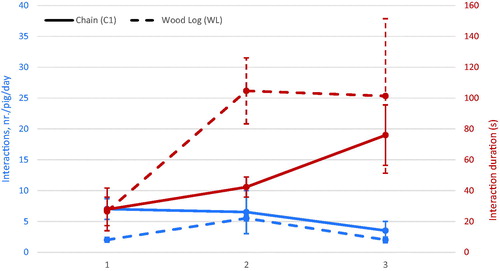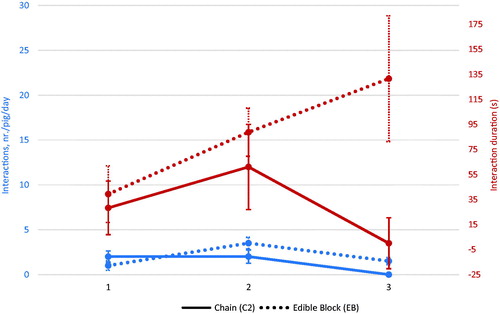Figures & data
Figure 1. Enrichment devices used in the present study. C: hanging chain; WL: wood logs placed inside a specifically-designed metal rack; ED: edible block placed inside the metal rack.

Table 1. Live weight and average daily gain (ADG) of heavy pigs receiving different environmental enrichment materials (C1 and C2 = hanging chains; WL = wood log; EB = edible block) in two different trials.
Figure 2. Median values (all-occurrences sampling) of the interactions with the environmental enrichment tools, metal chain (—) or wooden log (- - -), observed during Trial 1: median of the number of occurrences (blue lines) and average duration (red lines). Interactions were observed over 3 days, one at the beginning, one in the middle and one at the end of the experimental trial (points 1, 2 and 3 of the horizontal axis, respectively). The number of interactions significantly differed between the experimental groups (p < .01). The effect of time was also significant (p < .01 for interactions number, p < .001 for interaction duration).

Figure 3. Median values (all-occurrences sampling) of the interactions with the environmental enrichment tools, metal chain (—) or edible block (••••), observed during Trial 2: number of occurrences (blue lines) and average duration (red lines). Interactions were observed over 3 days, one at the beginning, one in the middle and one at the end of the experimental trial (points 1, 2 and 3 of the horizontal axis, respectively). The duration of interactions significantly differed between the experimental groups (p < .05). The effect of time was also significant (p < .01 for number of interactions, p < .05 for interaction duration).

Table 2. Diurnal behaviour (700 h–1900 h) of pigs that received different environmental enrichment materials in two different trials.
Table 3. Skin and tail lesions (assessed according to the Welfare Quality® protocol, 2009) of pigs receiving different environmental enrichment materials.
Table 4. Selected blood parameters and cortisol from bristles of heavy pigs (mean and Standard Error = SE) receiving different environmental enrichment materials.
